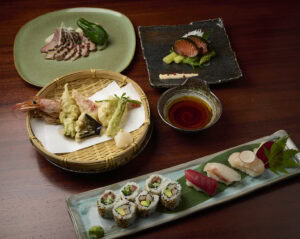Sushi comes in many different forms. Probably the best-known form of sushi internationally are sushi rolls, iconic with the contents in the middle and rice around it. The Japanese umbrella term for the various sushi rolls is makimono. The typical maki shapes are hosomaki, chūmaki and futomaki. In most traditional sushi restaurants in Japan, however, you will find - if at all - almost only Hosomaki (the majority of good sushi in Japan represent Nigiri and Gunkan dar).
What are Makimono?
Makimono is the umbrella term for various types of maki sushi.
Maki sushi (巻き寿司) is made from acetic rice and other ingredients by rolling them into a sheet of nori.
Nori is, at least today, the main ingredient to roll maki sushi. Modern interpretations also know other wrappings. A mat made of bamboo, called makisu, is used to roll the ingredients.
Maki sushi is now believed to have evolved from Bō sushi, in the late 18th century. Nori was not produced until the early 18th century in Edo (modern Tokyo) (see https://makizushi-club.com/story/).
Maki sushi can be made with a wide variety of ingredients. That's why there are so many different types of maki sushi, which (from a Japanese perspective) are constantly being reinvented, even abroad.
What is the best way to eat maki sushi?
Maki sushi is enjoyed with very little soy sauce.
The Soy sauce should be exactly on the border line between nori and rice. If maki sushi is slightly slanted, it is easier to place the soy sauce right there. Makizushi (the other spelling is just as valid) can be eaten with chopsticks or directly with your fingers.
Never use crude instruments such as knives and forks, which can interfere with the taste of sushi and disturb Japanese eyes.
On this occasion, it should also be mentioned again that it is decidedly strange for Japanese people when some foreigners put pickled ginger on the sushi rolls. You can find more about this in our article about "All about etiquette: how to eat sushi"..
Hoso-Maki - the "standard" rolls
Hoso-maki (細巻き) is made with half a sheet of nori.
The standard size of nori is 21 centimeters by 19 centimeters. Rice is placed on the nori, then one, maximum two other ingredients are placed on the rice for the center of the small rolls.
Then place the sheet around the center and press firmly. This allows the roll to be rolled up evenly and just tightly enough. Hoso-maki translates as "thin roll" - which is explained by the use of half the nori leaf. The rolls turn out very thin by using half the sheet and only a few ingredients.
The simple taste of hoso-maki makes these rolls a perfect ending to a successful sushi menu. And that's exactly where hoso-maki belong, according to the opinion of connoisseurs. Typically Japanese, the fine taste (of nigiri) should come first and later perhaps something to fill the stomach.
What are Chū-Maki?
Chū (中) means "middle" or "in the middle".
The name of these rolls probably comes from the fact that they are halfway between hoso-maki and futo-maki in terms of diameter.
This makes Chū-Maki perfect for filling remaining space in the bento box for which Hoso-Maki would be too small and Futo-Maki too large.
For Chū-maki is usually used half sheet of nori, as for hoso-maki. However, it is also possible to use a whole leaf. Usually two to three different ingredients are used for these medium rolls.
The exact origin of Chū-Maki is not clear.
Some sources claim that Chū-maki developed in a bento store about 60 years ago. Other sources hold that in Edo, now Tokyo, people preferred nigiri sushi and hosomaki, while in the Osaka region, futo maki and Chū-maki were preferred (see https://www.sushiacademy.co.jp/archives/7056).
What are futo maki?
Futo-maki (太巻き) means "thick roll," the Japanese adjective futoi (太い) translates as "thick."
A Futo Maki has a diameter of five centimeters, which is quite filling. Standard-sized nori is used for futo maki, and usually four other ingredients are included in addition to rice.
Futo-maki is preferred in the Kansai region, i.e. the area around Osaka. In sushi restaurants in the greater Tōkyō area, futo-maki can occasionally be found, but here hoso-maki actually dominates alongside nigiri. Although all types of sushi are widely known in all regions of Japan, preferences have persisted. Sweet and salty futo-maki belong to Ōsaka.
And an interesting custom also comes from the Kansai region: every year on Setsubun, February 3, the evil spirits are exorcised at the end of winter according to the Chinese calendar.
To bring good luck and prosperity, futo-maki are eaten on this day. These so-called ehō-maki (恵方巻き) are slightly thicker and are prepared with other ingredients that are not normally used, such as shiitake mushrooms (see https://ja.wikipedia.org/wiki/).
Originally, this custom was only practiced in the Kansai region, but in 1995, Seven-Eleven sold ehō-maki for the first time in western Japan, and from 1998 onwards, throughout Japan. Accordingly, this custom is now known throughout Japan (see https://de.wikipedia.org/wiki/Setsubun#Ehmaki).
What are Ura-Maki?
Ura-Maki (裏巻き) is actually not from Japan at all.
The signature California roll was invented in a sushi restaurant in California in the 1960s (see https://world-food.info/california-roll).
Since then, many different types of ura-maki have developed with a wide variety of ingredients. Ura-maki is always a treat for the eyes: bright colors and the only very subtle black of the nori make the rolls a statement in terms of aesthetics!
Ura-Maki means in German as much as "the inside turned outward". The term comes from the fact that the sheet of nori here is not on the outside of the rice, but is completely rolled inside.
Especially outside of Japan, Ura-Maki is really popular. However, with Japanese travelers all over the world and "foreign" travelers in Japan, ura-maki have now made it onto the menus of sushi restaurants in Japan. However, traditional sushi restaurants in Japan that value high quality and taste still resist ura-maki. The rolls are simply not perceived as authentic.

